Mitsubishi Outlander: Engine oil
To check and refill engine oil
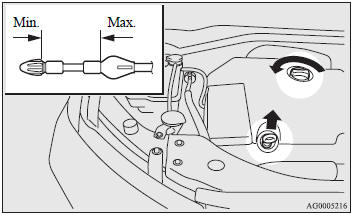
The engine oil used has a significant effect on the engine’s performance, service life and startability. Be sure to use oil of the recommended quality and appropriate viscosity. All engines consume a certain amount of oil during normal operation. Therefore, it is important to check the oil level at regular intervals or before starting a long trip. 1. Park the car on a horizontal surface. 2. Switch off the engine. 3. Wait a few minutes. 4. Remove the dipstick and wipe it with a clean cloth. 5. Reinsert the dipstick as far as it goes.
6. Remove the dipstick and read the oil level, which should always be within the range indicated 7. If the oil level is below the specified limit, remove the cap located on the cylinder head cover and add enough oil to raise the level to within the specified range. Do not overfill to avoid engine damage. Be sure to use the specified engine oil and do not mix various types of oil. 8. After adding oil, close the cap securely. 9. Confirm the oil level by repeating step 4 to 6. Use only the recommended oils with an ACEA or API classification as specified in this manual.
NOTE:
● Engine oil consumption is greatly influenced by payload, engine speed, etc. Depending
on how you drive, it can reach 1.0 lit./1,000 km.
● The engine oil will deteriorate rapidly if the vehicle is subjected to severe
conditions, requiring earlier oil replacement. Please refer to the maintenance schedule.
● For information on how to dispose of used engine oil, refer to page 7.
Recommended engine oil viscosity
Use engine oil conforming to the following classification: • “VW 50501/50601”.
NOTE:
● Use of additives is not recommended since they may reduce the effectiveness of
additives already included in the engine oil. It may result in failure of the mechanical
assembly.
Engine coolant
To check the coolant level
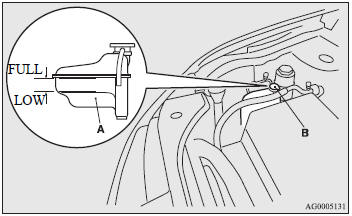
A transparent coolant reserve tank (A) is located in the engine compartment. The coolant level in this tank should be kept between the “LOW” and “FULL” marks when measured while the engine is cold.
To add coolant
The cooling system is a closed system and normally the loss of coolant should be very slight. A noticeable drop in the coolant level could indicate leakage. If this occurs, we recommend you to have the system checked as soon as possible. If the level should drop below the “LOW” level on the reserve tank, open the lid and add coolant.
WARNING:
● Do not open the reserve tank cap (B) while the engine is hot. The coolant system
is under pressure and any hot coolant escaping could cause severe burns.
Anti-freeze
The engine coolant contains an ethylene glycol anti-corrosion agent. The cylinder head and water pump housing are cast aluminium alloy, and periodic changing of the engine coolant is necessary to prevent corrosion of these parts. Use “BASF Glysantin Alu Protect Premium /G30” or equivalent. This coolant has excellent protection against corrosion and rust formation of all metals including aluminium and can avoid clogs in the radiator, heater, cylinder head, engine block, etc. Because of the necessity of this anti-corrosion agent, the coolant must not be replaced with plain water even in summer.
Washer fluid
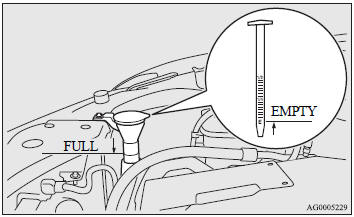
Open the washer fluid reservoir cap and check the level of washer fluid with the dipstick. If the level is low, replenish the container with washer fluid.
NOTE:
● The washer fluid container serves the windscreen, rear window and headlamps.
During cold weather
To ensure proper operation of the washers at low temperatures, use a fluid containing an anti-freezing agent.
Brake fluid/Clutch fluid
The brake fluid and the clutch fluid share reservoir tank.
To check the fluid level
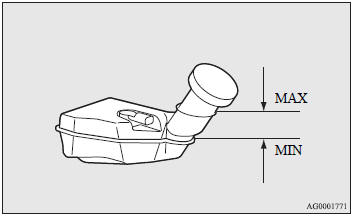
The fluid level must be between the “MAX” and “MIN” marks on the reservoir. The fluid level is monitored by a float. When the fluid level falls below the “MIN” mark, the brake fluid warning lamp lights up. The fluid level falls slightly with wear of the brake pads, but this does not indicate any abnormality. The fluid in the master cylinder should be checked when doing other work under the bonnet. The brake system should also be checked for leaks at the same time.
If the fluid level falls markedly in a short length of time, it indicates leaks from the brake system. If this occurs, we recommend you to have the vehicle checked.
Recommended fluid
Use brake fluid conforming to DOT3 or DOT4. The brake fluid is hygroscopic. Too much moisture in the brake fluid will adversely affect the brake system and clutch system, reducing the performance. The brake fluid reservoir uses a special cap to prevent air from entering the reservoir. Do not remove the cap.
CAUTION:
● Take care in handling brake fluid as it is harmful to the eyes, may irritate your
skin and also damage to painted surfaces.
● Use only the specified brake fluid. Also, the additives in different brands may
result in a chemical reaction when mixed together, so avoid mixing different brands.
● Normally, keep the reservoir tank cap closed to prevent the brake fluid from deteriorating.
Power steering fluid
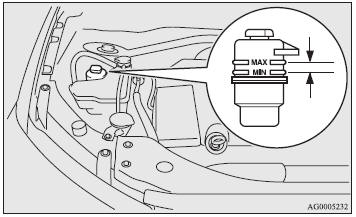
To check the fluid level
Check the fluid level in the reservoir while the engine is idling. Check to make certain that the power steering fluid level is always between the “MAX” and “MIN” level markings on the fluid reservoir and refill the fluid, if necessary.
Recommended fluid
Use “ATF DEXRON III or DEXRON II”.
See also:
Introduction
This owner’s manual applies to the GRAND VITARA series:
NOTE: The illustrated model is one of the GRAND VITARA series.
Thank you for choosing SUZUKI and welcome to our growing family. Your choice was a wise one; SUZUKI products are a great ...
Indicator lamp, warning lamp, and information screen display list
Indicator and warning lamp list
1- Turn-signal indicator lamps/Hazard warning indicator lamps → P. 3-50. 2- High-beam
indicator lamp → P. 3-50. 3- Diesel preheat indicator lamp → P. 3-50. 4- Position
lamp indicator lamp ͛ ...

 Service precautions
Service precautions